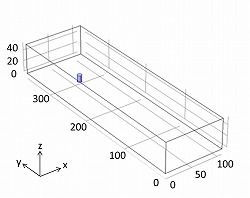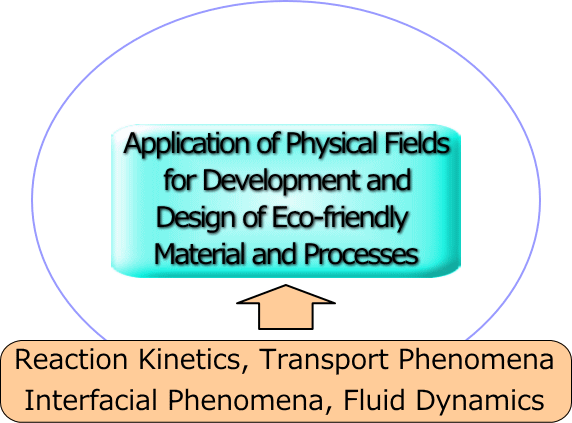Research
Our laboratory focusses on developing and designing eco-friendly materials and processes using physical fields, and on elucidating the effects of these fields on the reaction kinetics, transport and interface phenomena.
Examples of such fields include ultrasonic and electromagnetic fields, microwaves and plasma.
Some advantages of this approach are : (1) minimization of chemical waste, (2) reduction of process temperature, (3) improvement of material recyclability.
In this lab, the relationship between these interactions for heating and other phenomena are investigated. The purposes of research are developing specific non-equilibrium processes for fabrication of functional materials, and developing energy-saving processes for materials production, detoxification and recycling of industrial wastes by microwave irradiation. Currently, the following researches are conducted for the application in environmental engineering.
In this research,a vermiculite was taken as a model of clay minerals, non-radioactive Cs was doped to the aqueous suspension at an order of several ppb to ppm. The Cs- doped sediments were dried and immersed into water again. However, Cs was not dissolved out. The Cs-doped vermiculite was mixed with various salts in powder state and heated by microwave irradiation. It was possible to dissolved out Cs by occurrence of ion exchange reaction. After the treatment, dissolved concentration of Cs in water was measured by means of ICP-MS. Influence of microwave irradiation on the ion exchange reaction was investigated.




Some advantages of this approach are : (1) minimization of chemical waste, (2) reduction of process temperature, (3) improvement of material recyclability.
Micorwaves
Microwave is an electromagnetic wave, which interacts not only with molecules of water or organics, but also with electrons and/or atoms (ions) in metals and inorganic materials.In this lab, the relationship between these interactions for heating and other phenomena are investigated. The purposes of research are developing specific non-equilibrium processes for fabrication of functional materials, and developing energy-saving processes for materials production, detoxification and recycling of industrial wastes by microwave irradiation. Currently, the following researches are conducted for the application in environmental engineering.
1. Influence of microwave irradiation on exchange reaction with Cs ions adsorbed in layered silicates (clay minerals)
2. Fabrication of DPF (Diesel Particulate Filter) for combustion of PM(Particulate Matter) by microwave rapid heating
3. Development of energy-saving rapid annealing process of vapor deposited metal thin films by microwave irradiation
Clay soil consists of layered silicates, in which various ions (cations) are contained together with interlayer water.
Among many cations, Cs+ has strong binding with the layered crystal, because the ion diameter matches with the clearance in layer crystal ions.2. Fabrication of DPF (Diesel Particulate Filter) for combustion of PM(Particulate Matter) by microwave rapid heating
3. Development of energy-saving rapid annealing process of vapor deposited metal thin films by microwave irradiation
In this research,a vermiculite was taken as a model of clay minerals, non-radioactive Cs was doped to the aqueous suspension at an order of several ppb to ppm. The Cs- doped sediments were dried and immersed into water again. However, Cs was not dissolved out. The Cs-doped vermiculite was mixed with various salts in powder state and heated by microwave irradiation. It was possible to dissolved out Cs by occurrence of ion exchange reaction. After the treatment, dissolved concentration of Cs in water was measured by means of ICP-MS. Influence of microwave irradiation on the ion exchange reaction was investigated.
Comparing with gasoline engine, diesel engine is known to have advantages in energy-saving and low CO2 emission. However, the large amount emission of PM from egine waste gas is harmful to human and environment, and already caused serious problems.
Usually, PM in waste gas is collected with DPF and burned when the car stop after a certain driving distance. Recently, in order to cope with the PM2.5 problems, a filter with finer mesh is required, but it is much easier to choke filter.
Therefore, in oder to emit particles and burn them out fastly since the combustion, a DPF which could be heated quickly since the engine start is necessary.
In this research, it is intended to utilize microwave irradiation for rapid heating of DPF and combust the generated PM within DPF.
In this research, it is intended to utilize microwave irradiation for rapid heating of DPF and combust the generated PM within DPF.

Microwave cavity and sample

Predicted results of microwave energy absorption in DPF
In order to fabricate integrated electronic circuits, thin film is formed by vapor deposition techniques, such as metal films for wiring.
For the purpose of minimizing the thermal damage to the circuits, lower deposition temperature is favorable.
However, as the films consist of fine grains and sometimes are lack of crystallinity, the films usually do not have high electric conductivity.
Therefore, it is necessary to develope a rapid annealing treatment without causing thermal damages to the circuits.
Becasue the heating-selectivity of mircrowave, a efficient heating process with low electric cost could be achieved.
In this research, it is intended to develop rapid annealing process of metal thin films using a special method of separated microwave electric (E-) and magnetic (H-) field heating.
In this research, it is intended to develop rapid annealing process of metal thin films using a special method of separated microwave electric (E-) and magnetic (H-) field heating.


AFM image of Au thin film,
upper:as sputter - deposited state,
lower:After heating at 750℃ by microwave.
upper:as sputter - deposited state,
lower:After heating at 750℃ by microwave.

